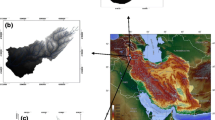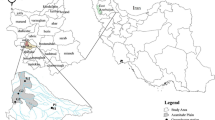Abstract
Karst aquifers are highly heterogeneous and exhibit hierarchical permeability structures or flow paths. Conduits and fractures typically account for less than 1 percent of the porosity of the aquifer, but more than 95 percent of the permeability. For the purposes of karst groundwater resources management, as well as of protection strategies against potential contamination, identifying the strong karst groundwater runoff belt of an entire aquifer system is generally more important than information about a specific spring. In this project, we introduce cross wavelet transform to analyze the relation between precipitation and spring discharge, and then identify the strong karst groundwater runoff belt. In highly concentrated karst areas, the precipitation signal can penetrate an aquifer relatively easily and will readily affect spring discharge. The precipitation and spring discharge are thus closely related, and the cross wavelet transform coefficients are large. Conversely, in areas of low karst concentration, the cross wavelet transform coefficients are small. We applied the method to Niangziguan Springs Basin in China to detect the strong karst groundwater runoff belt. Results showed that Pingding County and Yangquan City have a high degree of karstification (i.e. the strong karst groundwater runoff belt), Xiyang County and Shouyang County have a moderate degree of karstification, and Yuxian County, Heshun County, and Zuoquan County have a low degree of karstification. The results agree with the geological structure of Niangziguan Springs Basin.




Similar content being viewed by others
References
Adamowski JF (2008) Development of a short-term river flood forecasting method for snowmelt driven floods based on wavelet and cross-wavelet analysis. J Hydrol 353:247–266
Albuquerque MTD, Sanz G, Oliveira SF, Martincz-Alegria R, Antunes IMHR (2013) Spatio-Temporal Groundwater Vulnerability Assessment - A Coupled Remote Sensing and GIS Approach for Historical Land Cover Reconstruction. Water Resour Manage 27:4509–4526. doi:10.1007/s11269-013-0422-0
Amir N, Kafri U, Herut B, Shalev E (2013) Numerical Simulation of Submarine Groundwater Flow in the Coastal Aquifer at the Palmahim Area, the Mediterranean Coast of Israel. Water Resour Manage 27:4005–4020. doi:10.1007/s11269-013-0392-2
Chebud Y, Melesse A (2011) Operational prediction of groundwater fluctuation in South Florida using sequence based Markovian Stochastic Model. Water Resour Manag 25:2279–2294. doi:10.1007/s11269-011-9808-z
Dörfliger N, Fleury P, Ladouche B (2009) Inverse modeling approach to allogenic karst system characterization. Ground Water 47(3):414–426
Eaton TT (2006a) Heterogeneity in sedimentary aquifers: Challenges for characterization and flow modeling. Sediment Geol 184:183–186
Eaton TT (2006b) On the importance of geological heterogeneity for flow simulation. Sediment Geol 184:187–201
Fiorillo F, Guadagno FM (2010) Karst spring discharges analysis in relation to drought periods, using the SPI. Water Resour Manage 24:1867–1884
Froukh LJ (2002) Groundwater modelling in aquifers with highly karstic and heterogeneous characteristics (KHC) in Palestine. Water Resour Manag 16:369–379
Gao X, Wang Y, Ma T, Hu Q, Xing X, Yu Q (2011) Anthropogenic impact assessment of Niangziguan karst water. Proc Inst Civ Eng Waste Resour Manag 164:1–17
Grinsted A, Moore JC, Jevrejeva S (2004) Application of the cross wavelet transform and wavelet coherence to geophysical time series. Nonlinear Proc Geoph 11:561–566
Halford KJ (2004) More data required. Ground Water 42(4):447
Han D, Xu H, Liang X (2006) GIS-based regionalization of a karst water system in Xishan Mountain area of Taiyuan Basin, North China. J Hydrol 331(3–4):459–470
Han X, Lu R, Li Q (1993) Karst water system: A study on big karst spring in Shanxi. Geological Publishing, House (in Chinese)
Hao Y, Yeh TJ, Hu C, Wang Y, Li X (2006) Karst groundwater management by defining protection zones based on regional geological structures and groundwater flow fields. Environ Geol 50(3):415–422
Hao Y, Cao B, Chen X, Yin J, Sun R, Yeh TJ (2012a) A Piecewise Grey System Model for Study the Effects of Anthropogenic Activities on Karst Hydrological Processes Water Resour Manag DOI: 10.1007/s11269-012-0231-x, Published online
Hao Y, Liu G, Li H, Zhao J, Wang Y, Yeh TJ (2012b) Investigation of karstic hydrological processes of Niangziguan Springs (North China) using wavelet analyses. Hydrol Process 26:3062–306
Hartmann A, Martin K, Franko H, Jens L, Markus W (2012) Identification of a karst system’s intrinsic hydrodynamic parameters: upscaling from single springs to the whole aquifer. Environ Earth Sci 65:2377–2389
Hu C, Hao Y, Yeh TJ, Pang B, Wu Z (2008) Simulation of spring flows from a karst aquifer with an artificial neural network. Hydrol Process 22(5):596–604
Hudgins L, Huang J (1996) Bivariate wavelet analysis of Asia monsoon and ENSO. Adv Atmos Sci 13(3):299–31
Hudgins L, Friehe CA, Mayer ME (1993) Wavelet transform and Atmospheric Turbulence. Phys Rev Lett 71(20):3279–3282
Labat D (2010) Cross wavelet analyses of annual continental freshwater discharge and selected climate indices. J Hydrol 385:269–278
Lin HT, Ke KY, Tan YC, Wu SC, Gao H, Chen PC, Fang ST (2013) Estimating pumping rates and identifying potential recharge zones for groundwater management in multi-aquifers system. Water Resour Manage 27:3293–3306. doi:10.1007/s11269-013-0347-7
Maraun D, Kurths J (2004) Cross wavelet analysis: significance testing and pitfalls. Nonlinear Proc Geoph 11:505–514
Mylopoulos YA, Theodosiou N, Mylopoulos NA (1999) A stochastic optimization approach in the design of an aquifer remediation under hydrogeologic uncertainty. Water Resour Manag 13:335–351
Palmer AN (1991) Origin and morphology of limestone caves. Geol Soc Am Bull 103:1–21
Palmer AN (1999) Patterns of dissolution porosity in carbonate rocks, in Palmer, A.N., M. V. Palmer, and I. D. Sasowsky. eds., Karst modeling: Leesburg, Va. Karst Waters Institute Special Publication 5:71–78
Prokoph A, Bilali HE (2008) Cross-Wavelet analysis: a tool for detection of relationships between paleoclimate proxy records. Math Geosci 40(5):575–586. doi:10.1007/s11004-008-9170-8
Quinn JJ, Tomasko D, Kuiper JA (2006) Modeling complex flow in a karst aquifer. Sediment Geol 184:343–351
Sahay RR, Srivastava A (2013) Predicting monsoon floods in rivers embedding wavelet transform, genetic algorithm and neural network. Water Resour Manag 28(2):301–317. doi:10.1007/s11269-013-0446-5
Sang YF (2012) A practical guide to discrete wavelet decomposition of hydrologic time series. Water Resour Manage 26:3345–3365. doi:10.1007/s11269-012-0075-4
Singh SK, Srivastava PK, Pandey AC, GautamSK (2013) Integrated assessment of groundwater influenced by a confluence river system: concurrence with remote sensing and geochemical modelling. Water Resour Manage 27(12): 4291–4313. DOI 10.1007/s11269-013-0408-y
Sun W, Cheng B (2008) Application of Cross Wavelet Transformation to Analysis on Regional Climate Variations. J Appl Meteorol Clim 19(4):479–487
Tan KL (1995) Application of Satellite Images to Analysis of Structural Control of Karst Groundwater in Niangziguan springs. Jour Geol & Min Res North China 10(4):611–618 (in Chinese)
Taylor CJ, Greene EA (2008) Hydrogeologic Characterization and Methods Used in the Investigation of Karst Hydrology. Chapter 3 of Field Techniques for Estimating Water Fluxes Between Surface Water and Ground Water, Edited by Donald O. Rosenberry and James W. LaBaugh. U.S. Geological Survey, Reston, Virginia: 2008
Torrence C, Compo GP (1998) A practical guide to wavelet analysis. Geol Soc Am Bull 79:61–78
Wang Y, Zhang B, Guo L, Dai S, Wang X (2011a) Cross wavelet analysis and R/S analysis of relationship between Geomagnetic Ap Index and sunspot number. Scientia Geographica Sinica 31(6):747–752 (in Chinese)
Wang W, Hu S, Li Y (2011b) Wavelet transform method for synthetic generation of daily streamflow. Water Resour Manage 25(1):41–57
White WB, White EL (1989) Karst hydrology—Concepts from the Mammoth Cave area. Van Nostrand Reinhold, New York, p 346
Williams P (1983) The role of the subcutaneous zone in karst hydrology. J Hydrol 61:45–67
Worthington SRH, Davies GJ, Ford DC (2000) Matrix, fracture and channel components of storage and flow in a Paleozoic limestone aquifer. In: Sasowsky ID, Wicks CM (eds) Groundwater flow and contaminant transport in carbonate aquifers: Rotterdam. A.A. Balkema, Netherlands, pp 113–128
Xu CY, Singh VP (2004) Review on regional water resources assessment models under stationary and changing climate. Water Resour Manag 18:591–612
Yin D, Shu L, Chen X, Wang Z, Mohammed ME (2011) Assessment of Sustainable Yield of Karst Water in Huaibei, China. Water Resour Manag 25(1):287–300
Zuo Y (1987) Conceptual model of fissure karstic groundwater system of Niangziguan, Shanxi. B I Geomech CAGS 10:127–136 (in Chinese)
Acknowledgments
This work is partially funded by the National Natural Science Foundation of China (41272245, 40972165, 40572150). The authors are also grateful to Professor Xingrui Han for his suggestions in this article, and to Dr. Martha P. L. Whitaker for technical editing. Our gratitude is also extended to the AE and an anonymous reviewer for their efforts in reviewing the manuscript and their very encouraging, insightful, and constructive comments.
Author information
Authors and Affiliations
Corresponding author
Rights and permissions
About this article
Cite this article
Miao, J., Liu, G., Cao, B. et al. Identification of Strong Karst Groundwater Runoff Belt by Cross Wavelet Transform. Water Resour Manage 28, 2903–2916 (2014). https://doi.org/10.1007/s11269-014-0645-8
Received:
Accepted:
Published:
Issue Date:
DOI: https://doi.org/10.1007/s11269-014-0645-8




